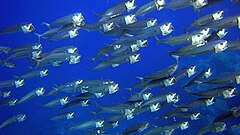No its not freshwater fish
Indian mackerel
From Wikipedia, the free encyclopedia
Indian mackerel
 Conservation status
Not evaluated
Conservation status
Not evaluated (
IUCN 3.1)
Scientific classification
Kingdom:
Animalia
Phylum:
Chordata
Class:
Actinopterygii
Order:
Perciformes
Family:
Scombridae
Tribe:
Scombrini
Genus:
Rastrelliger
Species:
R. kanagurta
Binomial name
Rastrelliger kanagurta
(
Cuvier, 1816)
 School
School of Indian mackerel
ram feedingon macroplanton

Indian Mackerel

Indian mackerel, cleaned with gashes and its eggs. The head portion is removed.

Indian Mackerel Fry
The
Indian mackerel (
Rastrelliger kanagurta) is a species of
mackerel in the scombrid family (family
Scombridae) of order
Perciformes.
[1] It is commonly found in the
Indian and
West Pacific oceans, and their surrounding seas. It is an important food fish and is commonly used in
South and
South-East Asian cuisine.
It is known by various names, such as 'Kembung' in
Indonesia,
Bangda(बांगडा) in
Marathi,
Aiyla(അയല, ഐല) in
Malayalam,
Aiyla Meen (அயிலா மீன்) in
Tamil and 'Bangude' (ಬಂಗುಡೆ) in
Tulu,
Konkani and
Kannada.
Contents
[
hide]
Distribution and habitat[edit]
The Indian mackerel is found in warm shallow waters along the coasts of the
Indian and
Western Pacific oceans. Its range extends from the
Red Sea and
East Africa in the west to
Indonesia in the east, and from
China and the
Ryukyu Islands in the north to
Australia,
Melanesia and
Samoa in the south. It has also entered the
Mediterranean Sea through the
Suez Canal.
[2]
Description[edit]
The body of the Indian mackerel is moderately deep, and the head is longer than the body depth. The maxilla are partly concealed, covered by the lacrimal bone, but extend till around the hind margin of the eye.
[3]
These fish have thin dark longitudinal bands on the upper part of the body, which may be golden on fresh specimens. There is also a black spot on the body near the lower margin of the pectoral fin. Dorsal fins are yellowish with black tips, while the caudal and pectoral fins are yellowish. The remaining fins are dusky.
[3]
Indian mackerel reach a maximum
fork length of 35 centimetres (14 in), but are generally around 25 centimetres (9.8 in) in length.
[2]
Habitat and diet[edit]
The Indian mackerel is generally found in
shallow,
coastal waters, where the surface water temperature is at least 17 °C (63 °F).
[3]Adults of this species are found in coastal bays, harbours and deep lagoons. They are commonly found in turbid waters rich in plankton.
[2]
Adult Indian mackerel feed on
macroplankton including the larvae of shrimp and fish.
[3]
Life history[edit]
The spawning season around India, which is in the northern hemisphere, is between March and September. Around Seychelles in the southern hemisphere, it is between September and the following March.
[4]
Spawning occurs in batches. The eggs are laid in the water and are externally fertilized. The Indian mackerel do not guard their eggs, which are left to develop on their own.
[5]
Juveniles feed on
phytoplankton like
diatoms and small
zooplankton including
cladocerans and
ostracods. As they mature, their intestines shorten, and their diet changes to primarily include
macroplankton such as the larvae of shrimp and fish.
[3]
As food[edit]
Called
Bangude in
Tulu, the fish is deep fried or pan fried with Rava or made in to a spicy curry called
Bangude puli munchi.




